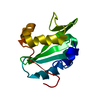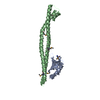+ Open data
Open data
- Basic information
Basic information
| Entry | Database: PDB / ID: 7myn | ||||||||||||||||||||||||||||||||||||||||||
|---|---|---|---|---|---|---|---|---|---|---|---|---|---|---|---|---|---|---|---|---|---|---|---|---|---|---|---|---|---|---|---|---|---|---|---|---|---|---|---|---|---|---|---|
| Title | Cryo-EM Structure of p110alpha in complex with p85alpha | ||||||||||||||||||||||||||||||||||||||||||
 Components Components |
| ||||||||||||||||||||||||||||||||||||||||||
 Keywords Keywords |  TRANSFERASE / TRANSFERASE /  phosphoinositide 3-kinase (PI3K) / phosphoinositide 3-kinase (PI3K) /  activation / activation /  inhibition / activity-dependent conformational changes inhibition / activity-dependent conformational changes | ||||||||||||||||||||||||||||||||||||||||||
| Function / homology |  Function and homology information Function and homology informationperinuclear endoplasmic reticulum membrane / response to muscle inactivity / negative regulation of actin filament depolymerization / regulation of toll-like receptor 4 signaling pathway / response to L-leucine / phosphatidylinositol kinase activity / regulation of actin filament organization / phosphatidylinositol 3-kinase regulator activity / response to butyrate / autosome genomic imprinting ...perinuclear endoplasmic reticulum membrane / response to muscle inactivity / negative regulation of actin filament depolymerization / regulation of toll-like receptor 4 signaling pathway / response to L-leucine / phosphatidylinositol kinase activity / regulation of actin filament organization / phosphatidylinositol 3-kinase regulator activity / response to butyrate / autosome genomic imprinting / positive regulation of focal adhesion disassembly / IRS-mediated signalling / cellular response to hydrostatic pressure / phosphatidylinositol 3-kinase activator activity / interleukin-18-mediated signaling pathway / PI3K events in ERBB4 signaling / myeloid leukocyte migration / phosphatidylinositol 3-kinase regulatory subunit binding / 1-phosphatidylinositol-3-kinase regulator activity / neurotrophin TRKA receptor binding / Activated NTRK2 signals through PI3K / positive regulation of protein localization to membrane / cis-Golgi network / Activated NTRK3 signals through PI3K / kinase activator activity / ErbB-3 class receptor binding / negative regulation of fibroblast apoptotic process / RHOF GTPase cycle / cardiac muscle cell contraction / phosphatidylinositol 3-kinase complex, class IB / vasculature development /  transmembrane receptor protein tyrosine kinase adaptor activity / RHOD GTPase cycle / positive regulation of endoplasmic reticulum unfolded protein response / Signaling by cytosolic FGFR1 fusion mutants / transmembrane receptor protein tyrosine kinase adaptor activity / RHOD GTPase cycle / positive regulation of endoplasmic reticulum unfolded protein response / Signaling by cytosolic FGFR1 fusion mutants /  regulation of cellular respiration / enzyme-substrate adaptor activity / regulation of cellular respiration / enzyme-substrate adaptor activity /  phosphatidylinositol 3-kinase complex / phosphatidylinositol 3-kinase complex /  anoikis / Nephrin family interactions / 1-phosphatidylinositol-4-phosphate 3-kinase activity / RND1 GTPase cycle / Costimulation by the CD28 family / vascular endothelial growth factor signaling pathway / 1-phosphatidylinositol-4,5-bisphosphate 3-kinase activity / RND2 GTPase cycle / MET activates PI3K/AKT signaling / PI3K/AKT activation / RND3 GTPase cycle / positive regulation of leukocyte migration / anoikis / Nephrin family interactions / 1-phosphatidylinositol-4-phosphate 3-kinase activity / RND1 GTPase cycle / Costimulation by the CD28 family / vascular endothelial growth factor signaling pathway / 1-phosphatidylinositol-4,5-bisphosphate 3-kinase activity / RND2 GTPase cycle / MET activates PI3K/AKT signaling / PI3K/AKT activation / RND3 GTPase cycle / positive regulation of leukocyte migration /  phosphatidylinositol-4,5-bisphosphate 3-kinase / positive regulation of filopodium assembly / phosphatidylinositol 3-kinase complex, class IA / negative regulation of stress fiber assembly / phosphatidylinositol-4,5-bisphosphate 3-kinase / positive regulation of filopodium assembly / phosphatidylinositol 3-kinase complex, class IA / negative regulation of stress fiber assembly /  phosphatidylinositol 3-kinase / relaxation of cardiac muscle / growth hormone receptor signaling pathway / phosphatidylinositol-3-phosphate biosynthetic process / phosphatidylinositol 3-kinase / relaxation of cardiac muscle / growth hormone receptor signaling pathway / phosphatidylinositol-3-phosphate biosynthetic process /  insulin binding / 1-phosphatidylinositol-3-kinase activity / RHOV GTPase cycle / negative regulation of macroautophagy / RHOB GTPase cycle / Signaling by ALK / negative regulation of cell-matrix adhesion / GP1b-IX-V activation signalling / PI-3K cascade:FGFR3 / Erythropoietin activates Phosphoinositide-3-kinase (PI3K) / protein kinase activator activity / response to dexamethasone / PI-3K cascade:FGFR2 / PI-3K cascade:FGFR4 / RHOJ GTPase cycle / RHOC GTPase cycle / PI-3K cascade:FGFR1 / negative regulation of osteoclast differentiation / intracellular glucose homeostasis / CD28 dependent PI3K/Akt signaling / Synthesis of PIPs at the plasma membrane / phosphatidylinositol phosphate biosynthetic process / CDC42 GTPase cycle / RHOU GTPase cycle / PI3K events in ERBB2 signaling / Signaling by ALK fusions and activated point mutants / RHOG GTPase cycle / negative regulation of anoikis / RET signaling / T cell differentiation / regulation of multicellular organism growth / extrinsic apoptotic signaling pathway via death domain receptors / insulin binding / 1-phosphatidylinositol-3-kinase activity / RHOV GTPase cycle / negative regulation of macroautophagy / RHOB GTPase cycle / Signaling by ALK / negative regulation of cell-matrix adhesion / GP1b-IX-V activation signalling / PI-3K cascade:FGFR3 / Erythropoietin activates Phosphoinositide-3-kinase (PI3K) / protein kinase activator activity / response to dexamethasone / PI-3K cascade:FGFR2 / PI-3K cascade:FGFR4 / RHOJ GTPase cycle / RHOC GTPase cycle / PI-3K cascade:FGFR1 / negative regulation of osteoclast differentiation / intracellular glucose homeostasis / CD28 dependent PI3K/Akt signaling / Synthesis of PIPs at the plasma membrane / phosphatidylinositol phosphate biosynthetic process / CDC42 GTPase cycle / RHOU GTPase cycle / PI3K events in ERBB2 signaling / Signaling by ALK fusions and activated point mutants / RHOG GTPase cycle / negative regulation of anoikis / RET signaling / T cell differentiation / regulation of multicellular organism growth / extrinsic apoptotic signaling pathway via death domain receptors /  insulin receptor substrate binding / insulin receptor substrate binding /  Interleukin-3, Interleukin-5 and GM-CSF signaling / PI3K Cascade / Interleukin-3, Interleukin-5 and GM-CSF signaling / PI3K Cascade /  intercalated disc / RHOA GTPase cycle / positive regulation of TOR signaling / endothelial cell migration / RAC2 GTPase cycle / RAC3 GTPase cycle / GAB1 signalosome intercalated disc / RHOA GTPase cycle / positive regulation of TOR signaling / endothelial cell migration / RAC2 GTPase cycle / RAC3 GTPase cycle / GAB1 signalosomeSimilarity search - Function | ||||||||||||||||||||||||||||||||||||||||||
| Biological species |   Homo sapiens (human) Homo sapiens (human) | ||||||||||||||||||||||||||||||||||||||||||
| Method |  ELECTRON MICROSCOPY / ELECTRON MICROSCOPY /  single particle reconstruction / single particle reconstruction /  cryo EM / Resolution: 2.79 Å cryo EM / Resolution: 2.79 Å | ||||||||||||||||||||||||||||||||||||||||||
 Authors Authors | Liu, X. / Yang, S. / Hart, J.R. / Xu, Y. / Zou, X. / Zhang, H. / Zhou, Q. / Xia, T. / Zhang, Y. / Yang, D. ...Liu, X. / Yang, S. / Hart, J.R. / Xu, Y. / Zou, X. / Zhang, H. / Zhou, Q. / Xia, T. / Zhang, Y. / Yang, D. / Wang, M.-W. / Vogt, P.K. | ||||||||||||||||||||||||||||||||||||||||||
| Funding support |  United States, United States,  China, 13items China, 13items
| ||||||||||||||||||||||||||||||||||||||||||
 Citation Citation |  Journal: Proc Natl Acad Sci U S A / Year: 2021 Journal: Proc Natl Acad Sci U S A / Year: 2021Title: Cryo-EM structures of PI3Kα reveal conformational changes during inhibition and activation. Authors: Xiao Liu / Su Yang / Jonathan R Hart / Yingna Xu / Xinyu Zou / Huibing Zhang / Qingtong Zhou / Tian Xia / Yan Zhang / Dehua Yang / Ming-Wei Wang / Peter K Vogt /   Abstract: Phosphoinositide 3-kinases (PI3Ks) are lipid kinases essential for growth and metabolism. Their aberrant activation is associated with many types of cancers. Here we used single-particle cryoelectron ...Phosphoinositide 3-kinases (PI3Ks) are lipid kinases essential for growth and metabolism. Their aberrant activation is associated with many types of cancers. Here we used single-particle cryoelectron microscopy (cryo-EM) to determine three distinct conformations of full-length PI3Kα (p110α-p85α): the unliganded heterodimer PI3Kα, PI3Kα bound to the p110α-specific inhibitor BYL-719, and PI3Kα exposed to an activating phosphopeptide. The cryo-EM structures of unbound and of BYL-719-bound PI3Kα are in general accord with published crystal structures. Local deviations are presented and discussed. BYL-719 stabilizes the structure of PI3Kα, but three regions of low-resolution extra density remain and are provisionally assigned to the cSH2, BH, and SH3 domains of p85. One of the extra density regions is in contact with the kinase domain blocking access to the catalytic site. This conformational change indicates that the effects of BYL-719 on PI3Kα activity extend beyond competition with adenosine triphosphate (ATP). In unliganded PI3Kα, the DFG motif occurs in the "in" and "out" positions. In BYL-719-bound PI3Kα, only the DFG-in position, corresponding to the active conformation of the kinase, was observed. The phosphopeptide-bound structure of PI3Kα is composed of a stable core resolved at 3.8 Å. It contains all p110α domains except the adaptor-binding domain (ABD). The p85α domains, linked to the core through the ABD, are no longer resolved, implying that the phosphopeptide activates PI3Kα by fully releasing the niSH2 domain from binding to p110α. The structures presented here show the basal form of the full-length PI3Kα dimer and document conformational changes related to the activated and inhibited states. | ||||||||||||||||||||||||||||||||||||||||||
| History |
|
- Structure visualization
Structure visualization
| Movie |
 Movie viewer Movie viewer |
|---|---|
| Structure viewer | Molecule:  Molmil Molmil Jmol/JSmol Jmol/JSmol |
- Downloads & links
Downloads & links
- Download
Download
| PDBx/mmCIF format |  7myn.cif.gz 7myn.cif.gz | 255.8 KB | Display |  PDBx/mmCIF format PDBx/mmCIF format |
|---|---|---|---|---|
| PDB format |  pdb7myn.ent.gz pdb7myn.ent.gz | 195.7 KB | Display |  PDB format PDB format |
| PDBx/mmJSON format |  7myn.json.gz 7myn.json.gz | Tree view |  PDBx/mmJSON format PDBx/mmJSON format | |
| Others |  Other downloads Other downloads |
-Validation report
| Arichive directory |  https://data.pdbj.org/pub/pdb/validation_reports/my/7myn https://data.pdbj.org/pub/pdb/validation_reports/my/7myn ftp://data.pdbj.org/pub/pdb/validation_reports/my/7myn ftp://data.pdbj.org/pub/pdb/validation_reports/my/7myn | HTTPS FTP |
|---|
-Related structure data
| Related structure data |  24081MC  7myoC M: map data used to model this data C: citing same article ( |
|---|---|
| Similar structure data |
- Links
Links
- Assembly
Assembly
| Deposited unit | 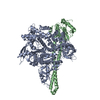
|
|---|---|
| 1 |
|
- Components
Components
| #1: Protein | Mass: 127822.578 Da / Num. of mol.: 1 Source method: isolated from a genetically manipulated source Source: (gene. exp.)   Homo sapiens (human) / Gene: PIK3CA / Plasmid: pFastBac Dual Homo sapiens (human) / Gene: PIK3CA / Plasmid: pFastBac DualDetails (production host): Baculovirus produces both PIK3CA and PIK3R1 simultaneously Cell (production host): BTI-TN-5B1-4 / Production host:   Trichoplusia ni (cabbage looper) Trichoplusia ni (cabbage looper)References: UniProt: P42336,  phosphatidylinositol-4,5-bisphosphate 3-kinase, phosphatidylinositol-4,5-bisphosphate 3-kinase,  non-specific serine/threonine protein kinase non-specific serine/threonine protein kinase |
|---|---|
| #2: Protein | Mass: 83623.203 Da / Num. of mol.: 1 Source method: isolated from a genetically manipulated source Source: (gene. exp.)   Homo sapiens (human) / Gene: PIK3R1, GRB1 / Plasmid: pFastBac Dual Homo sapiens (human) / Gene: PIK3R1, GRB1 / Plasmid: pFastBac DualDetails (production host): Baculovirus produces both PIK3CA and PIK3R1 simultaneously Cell (production host): BTI-TN-5B1-4 / Production host:   Trichoplusia ni (cabbage looper) / References: UniProt: P27986 Trichoplusia ni (cabbage looper) / References: UniProt: P27986 |
| #3: Water | ChemComp-HOH /  Water Water |
-Experimental details
-Experiment
| Experiment | Method:  ELECTRON MICROSCOPY ELECTRON MICROSCOPY |
|---|---|
| EM experiment | Aggregation state: PARTICLE / 3D reconstruction method:  single particle reconstruction single particle reconstruction |
- Sample preparation
Sample preparation
| Component | Name: Heterodimer of PIK3CA with PIK3R1 / Type: COMPLEX / Entity ID: #1-#2 / Source: RECOMBINANT |
|---|---|
| Molecular weight | Value: 0.2 MDa / Experimental value: NO |
| Source (natural) | Organism:   Homo sapiens (human) / Cellular location: Membrane associated Homo sapiens (human) / Cellular location: Membrane associated |
| Source (recombinant) | Organism:   Trichoplusia ni (cabbage looper) / Cell: BTI-TN-5B1-4 / Plasmid Trichoplusia ni (cabbage looper) / Cell: BTI-TN-5B1-4 / Plasmid : pFastBac Dual : pFastBac Dual |
| Buffer solution | pH: 7.6 |
| Specimen | Conc.: 1 mg/ml / Embedding applied: NO / Shadowing applied: NO / Staining applied : NO / Vitrification applied : NO / Vitrification applied : YES : YES |
| Specimen support | Grid material: GRAPHENE OXIDE / Grid mesh size: 300 divisions/in. / Grid type: Quantifoil R1.2/1.3 |
Vitrification | Instrument: FEI VITROBOT MARK IV / Cryogen name: ETHANE |
- Electron microscopy imaging
Electron microscopy imaging
| Experimental equipment |  Model: Titan Krios / Image courtesy: FEI Company |
|---|---|
| Microscopy | Model: FEI TITAN KRIOS |
| Electron gun | Electron source : OTHER / Accelerating voltage: 300 kV / Illumination mode: OTHER : OTHER / Accelerating voltage: 300 kV / Illumination mode: OTHER |
| Electron lens | Mode: BRIGHT FIELD Bright-field microscopy / Calibrated magnification: 46685 X / Calibrated defocus min: -1500 nm / Calibrated defocus max: -2500 nm Bright-field microscopy / Calibrated magnification: 46685 X / Calibrated defocus min: -1500 nm / Calibrated defocus max: -2500 nm |
| Image recording | Electron dose: 70 e/Å2 / Film or detector model: GATAN K3 (6k x 4k) / Num. of real images: 4023 |
| Image scans | Width: 5760 / Height: 4092 |
- Processing
Processing
| Software |
| |||||||||||||||||||||||||
|---|---|---|---|---|---|---|---|---|---|---|---|---|---|---|---|---|---|---|---|---|---|---|---|---|---|---|
| EM software |
| |||||||||||||||||||||||||
CTF correction | Type: PHASE FLIPPING AND AMPLITUDE CORRECTION | |||||||||||||||||||||||||
| Particle selection | Num. of particles selected: 332105 | |||||||||||||||||||||||||
3D reconstruction | Resolution: 2.79 Å / Resolution method: FSC 0.143 CUT-OFF / Num. of particles: 332105 / Symmetry type: POINT | |||||||||||||||||||||||||
| Atomic model building | B value: 98.68 / Protocol: FLEXIBLE FIT / Space: REAL / Target criteria: Correlation coefficient | |||||||||||||||||||||||||
| Atomic model building |
| |||||||||||||||||||||||||
| Refinement | Cross valid method: NONE Stereochemistry target values: GeoStd + Monomer Library + CDL v1.2 | |||||||||||||||||||||||||
| Displacement parameters | Biso mean: 90.31 Å2 | |||||||||||||||||||||||||
| Refine LS restraints |
|
 Movie
Movie Controller
Controller




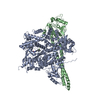

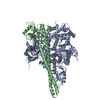
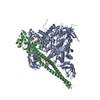
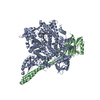
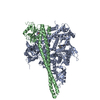
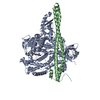

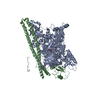

 PDBj
PDBj




















